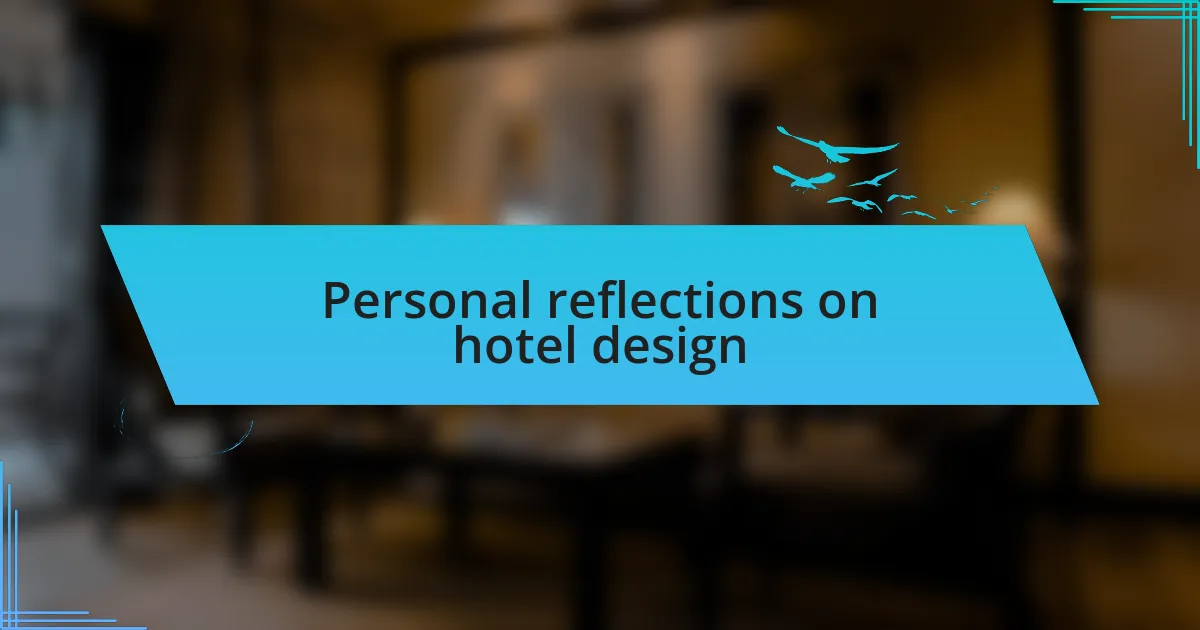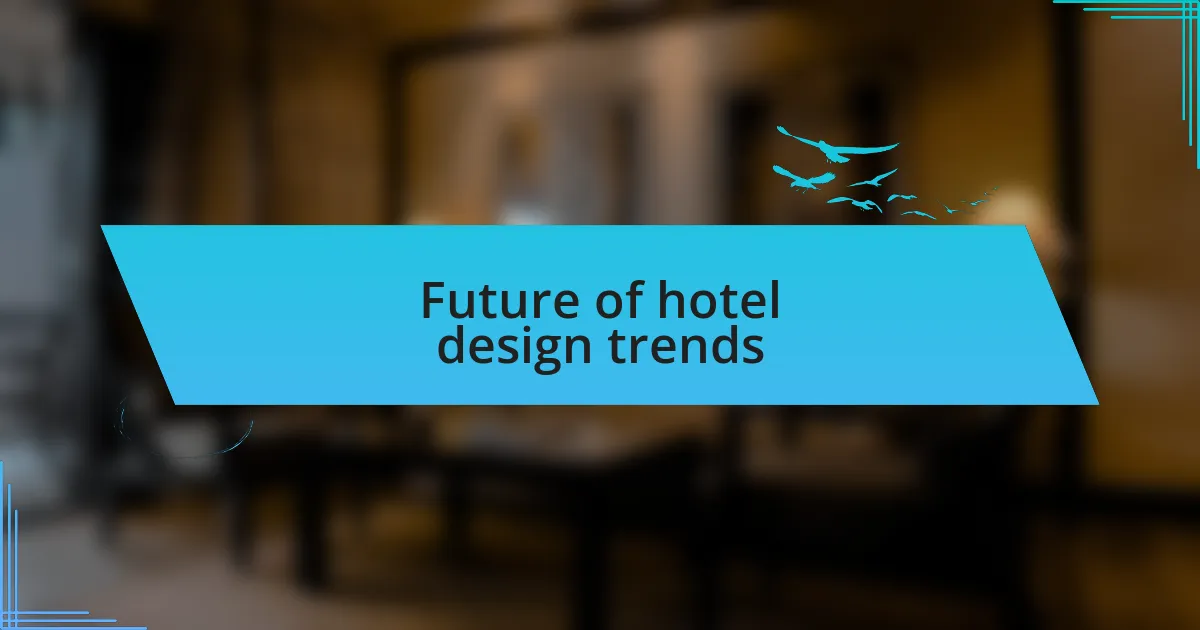Key takeaways:
- Hotel design trends focus on sustainability, biophilic design, and technology integration to enhance guest experiences.
- Functional design improves navigation and emotional impact, contributing to a sense of comfort and connection with the hotel’s branding.
- Incorporating local elements and art into hotel design fosters authenticity and enriches the overall guest experience.
- The future of hotel design will likely emphasize smart technology and environmental sustainability to create personalized and eco-friendly experiences.

Overview of hotel design trends
Hotel design trends are continually evolving, reflecting changes in traveler preferences and technological advancements. Recently, I’ve noticed a significant shift towards sustainability, with many hotels integrating eco-friendly materials and energy-efficient systems. Have you ever stayed in a place that made you feel like you were a part of something bigger than just a vacation? That’s the magic of sustainable design.
Another trend I’m excited about is the rise of biophilic design, which emphasizes the connection between humans and nature. I remember walking into a hotel adorned with indoor gardens and natural light streaming through large windows. It felt rejuvenating, almost like a breath of fresh air amidst a bustling city. This trend not only enhances aesthetic appeal but also contributes to guests’ well-being.
Moreover, it’s fascinating how technology has permeated hotel design. With smart rooms that allow guests to control lighting, temperature, and even entertainment through their devices, the emphasis on convenience is clear. One time, I was astounded by how easily I could adjust my room ambiance with just a tap on my phone. Can you imagine how much more comfortable travel becomes when design caters to our tech-savvy lifestyles?

Importance of hotel design
When I think about the importance of hotel design, I can’t help but recall my stay at a boutique hotel that was both stylish and functional. The layout facilitated movement, making it easy to navigate from the lobby to my room without feeling lost or overwhelmed. I believe that a well-thought-out design can significantly enhance the guest experience, allowing them to feel at home even in a new environment.
Moreover, the emotional impact of great design shouldn’t be underestimated. I’ve found that hotels with carefully curated spaces can evoke a sense of calm or excitement, depending on the atmosphere they aim to create. For instance, a chic, modern aesthetic might energize travelers, while soft, warm colors might make them feel relaxed. Isn’t it incredible how design can influence our mood and overall experience?
Lastly, the importance of hotel design extends beyond mere aesthetics. It reflects a hotel’s brand identity and communicates its values to guests. I once noticed that a family-run hotel infused local culture into its design, showcasing handmade crafts and traditional colors. This attention to detail not only made the space unique but also created a deeper connection with the destination, enriching my stay in ways I hadn’t anticipated.

Key elements of hotel design
When I think about the key elements of hotel design, functionality comes to mind first. A great example was my recent stay at a hotel that maximized space with smart furnishings. The multipurpose furniture not only saved room but also added a clever touch that made me feel like I was in a stylish urban apartment rather than a generic hotel room.
Another crucial aspect is the atmosphere, created through lighting and color schemes. I remember entering a lobby filled with soft, ambient lighting and warm hues; it instantly put me at ease after a long day of travel. It’s fascinating how the right lighting can transform a space—wouldn’t you agree that a well-lit environment doesn’t just reveal a hotel’s design but also enhances our feelings of comfort?
Lastly, the incorporation of local elements into the design is something that truly resonates with me. At a seaside hotel I visited, local art adorned the walls, showcasing the region’s rich culture. These touches made the place feel authentic and connected to the area, marking the experience as more than just a stay—it felt like a cultural immersion. How important do you think it is for hotels to reflect their surroundings in their design? I believe it creates lasting memories that guests cherish long after they check out.

Popular hotel design styles
When I think of popular hotel design styles, the first that comes to mind is the minimalist approach. I once stayed at a boutique hotel where clean lines and uncluttered spaces were the norm. It created a calming atmosphere that helped me unwind instantly; minimalism really allows guests to feel a sense of peace, don’t you think?
A rustic design style also holds a special place in my heart. I fondly recall a mountain lodge where the use of natural materials, like reclaimed wood and stone, made it feel like a cozy retreat. It was as if the hotel was embracing the beauty of nature right inside its walls, which created an inviting environment. What an incredible feeling it is to be surrounded by warmth and authenticity, reflecting the landscape outside!
Then there’s the contemporary style, which often features bold colors and striking artwork. I had an unforgettable experience at a city hotel that utilized a vibrant color palette, making each space feel alive. The dynamic design was so invigorating that it inspired me to explore the city, as though the hotel itself was a gateway to adventure. Isn’t it interesting how a well-thought-out design can spark wanderlust?

Sustainable hotel design practices
Sustainable hotel design practices truly resonate with me. I remember checking into a hotel that showcased renewable energy sources, like solar panels on the roof. It sparked a conversation amongst my friends and me about how such eco-friendly initiatives can significantly reduce a hotel’s carbon footprint, don’t you think?
One striking aspect I’ve encountered is the use of locally sourced materials in construction and decor. At a charming coastal resort, I noticed that they used stones from nearby quarries for their pathways and even in the lobby. It not only added a unique character to the hotel but also supported local artisans, creating a beautiful symbiotic relationship with the environment.
Water conservation systems are another essential trend I’ve come across. During a stay at a desert hotel, I experienced how their innovative rainwater harvesting system made a tangible difference. It felt rewarding to know that such practices help conserve precious resources while still providing guests with comfort and luxury. Isn’t it refreshing to see hotels leading the way towards a more sustainable future?

Personal reflections on hotel design
Personal reflections on hotel design
When I think about hotel design, the aesthetics and atmosphere play a crucial role in shaping my experience. I recall staying at a boutique hotel where each room had a unique theme and design, from modern minimalist to vintage charm. It was fascinating how the decor not only reflected the local culture but also became a conversation starter with fellow guests. How impactful can a beautifully curated space be on one’s stay?
Color also influences my perception of comfort in hotel settings. I remember stepping into a lobby adorned with warm hues and natural light pouring in through large windows. It instantly put me at ease, showing me how thoughtful design can create a welcoming ambiance. Have you ever entered a space and felt an immediate emotional lift? I certainly have, and it’s a powerful reminder of the role that design plays in our experiences.
Lastly, I’ve noticed that the layout and functionality of hotel spaces significantly affect guest interactions. At a recent hotel, the communal areas were designed to encourage mingling, with cozy seating arrangements and inviting fire pits that drew guests together. I loved the feeling of community it fostered, which made me wonder—what design elements contribute to memorable connections in these spaces? The choices made in hotel design truly shape our shared experiences.

Future of hotel design trends
As I look ahead to the future of hotel design trends, I can’t help but feel excited about the integration of technology. Imagine entering a room where the lighting automatically adjusts to your preferences and the temperature is just how you like it. It’s not just about convenience; it’s the way these smart features can transform a stay into a personalized experience that truly resonates with me. How often do we crave environments that adapt to our needs?
Another aspect I envision becoming more prominent is sustainability. I recall visiting a hotel that utilized reclaimed materials and solar panels, creating a strong connection to the natural environment. It made me feel good knowing that my stay contributed to eco-friendliness. What if future hotels could push this even further by incorporating vertical gardens or advanced waste management systems? It’s a pattern I hope will prevail, nurturing both guests and our planet.
Lastly, the concept of biophilic design, which seeks to connect guests with nature, definitely piques my interest. I once stayed at a hotel that featured large windows overlooking a forest, making the natural scenery an integral part of the experience. It was captivating how the greenery outside made the space feel alive and vibrant. Could this trend redefine our idea of relaxation in hotels, bringing the outside in and blurring the lines between indoor and outdoor living? I believe there’s profound potential in these future design approaches that can shape unforgettable experiences.